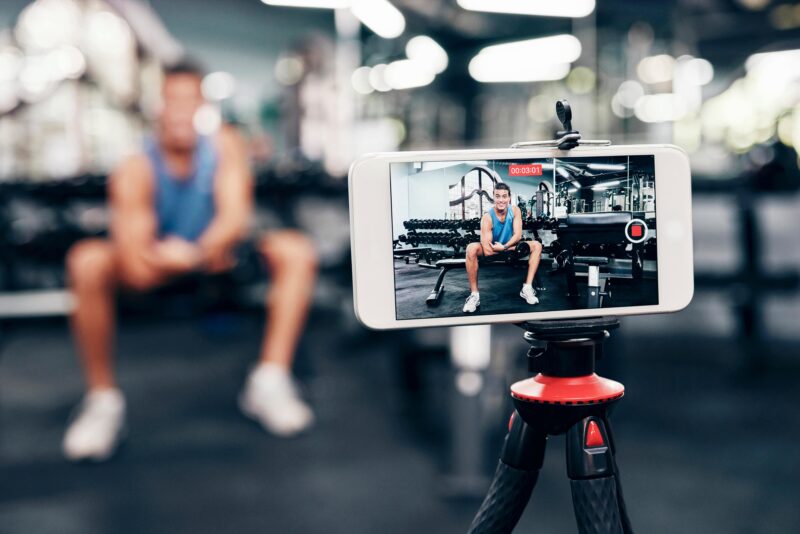Over 4.5 billion people use social media worldwide, with that number projected to expand to almost 6 billion in 2027. Among those billions are fitness club members, scrolling through their social media feeds daily. Engaging members online is a chance to capture their attention while developing relationships and growing memberships.
Let’s take a closer look at the role of social media and how it can affect your fitness club.

Why is Social Media Important for Fitness Clubs?
40% of consumers find the perfect product through a business’s social post. Each like, comment, and share represents potential leads and revenue. The top benefits of leveraging social media for fitness clubs include:
Better Brand Visibility
In the highly competitive fitness industry, finding and understanding what a club has to offer, can make or break your club. Social media allows you to highlight your club’s distinctive identity, values, and offerings to a broader audience. Sharing compelling content strengthens your online presence, increases fitness club awareness with potential members, and keeps current members engaged.
Stronger Member Loyalty
Fitness clubs are community hubs. Members want to interact with those who share their passion for health and wellness.
Social media enables you to foster a sense of belonging and engagement among members. You can create a virtual space where members can interact, share their fitness journeys, and provide valuable feedback. This sense of community can significantly improve member retention rates and encourage members to meet up for activities at the club.
Elevated Credibility
Positioning your fitness club as a valuable health and wellness resource is vital. Social media allows you to highlight your expertise by sharing informative and inspiring information. By consistently offering tips, nutritional guidance, and staying up to date with the latest health and wellness trends, you can position your club as the primary authority in the space. This not only attracts potential members but also strengthens your credibility among existing ones.
Greater Agility
The fitness industry is ever evolving, with new trends, challenges, and opportunities constantly emerging. Social media enables you to stay nimble and adapt to these changes swiftly. Whether you’re announcing new classes, safety protocols, or sharing member success stories, you can keep your members informed and engaged.
Increased Revenue
Providing an exceptional member experience is the key to revenue growth. Social media can be a powerful sales tool when used strategically to elevate member experiences. By promoting additional services such as personal training sessions, special classes, or membership upgrades, you stand to boost revenue while providing valuable options to your members.

10 Social Media Strategy Do’s and Don’ts
1. DON’T Try to Market to Everyone
Aiming to please everyone by generalizing your posts and broadening your appeal dilutes your club’s brand and makes your posts less engaging. Instead, create social media content that speaks specifically to your club’s target audience.
Consider the type of content your club’s niche audience wants to see and find opportunities to provide it. Crafting content that reflects your members’ needs and interests makes them feel seen and valued, turning casual social scrollers into a community of dedicated members.
2. DON’T Copy Another Club’s Strategy
Your members are unique. The social media strategy that works for your competitors may not resonate with your members. Competitors that are enjoying social media success have defined their target audience and learned what content resonates with them. You’ll need to go through the same process to see equivalent results.
92% of business leaders agree that social media insights have a positive impact on improving competitive positioning. View your competitors as a learning opportunity, not as a blueprint for your entire social media strategy. Study their success stories and apply the principles to your club’s strategy through the lens of your members’ unique needs.
3. DON’T Spend All Your Time Selling
According to The Sprout Social Index, only 27% of members want to see social media content about contests or promotions. People come to social media to be entertained, educated, and inspired.
Post promotional content wisely. This type of content is important, but there’s a fine line between offering value and spamming members. When your feed is primarily full of valuable and entertaining content, the occasional promotion is more likely to be well-received.
4. DON’T Try to Use Every Platform
Each social media channel has its own best practices, and nuances. If you try to master every platform at once, maintaining your club’s social presence will quickly demand more time than other operating responsibilities.
Instead, pick one or two social media platforms that resonate with your target audience and focus your efforts there. Starting with a manageable scope that allows you to build an engaged community around your club without spreading your resources too thin.
5. DON’T Post for the Sake of Posting
Posting frequently to keep your gym in the public eye may seem positive, but without a well-defined strategy you’re just making noise. Instead of posting for the sake of activity, use your social platforms to serve larger business objectives. Whether it’s increasing sign-ups for a special class, sharing nutritional tips, or motivating members with success stories, every post should serve a purpose that supports your fitness club marketing strategies.

6. DO Focus on Your Community
Your social media feed should offer a glimpse into the life as a member at your club. Use your social posts to highlight the member experience and increase your followers’ interest in joining.
Share new or user generated content about these topics to create an emotional connection and serve as social proof for prospective members:
- Member success stories
- Motivational quotes
- The relationships your club has fostered
- Your community’s approach to fitness and wellness
- Member trends
- Classes being offered
- Fun in-club activities for your members
7. DO Stay on Brand
94% of business leaders agree that social media data and insights have a positive impact on building brand reputation and loyalty. When followers engage with your club, they’re showing they trust your brand enough to invest their hard-earned money, time, and health. Every aspect of your online presence should support that relationship and strengthen trust.
Inconsistent online branding makes viewers confused about what your club offers. Keep your branding cohesive across your fitness club’s online presence to build trust and set a premium standard for your club.
Make sure all these elements are consistent across your fitness club’s website, social media profiles, and other platforms:
- Color palette
- Voice and messaging
- Bio and About Us information
- Profile pictures and logos
- Banners and imagery
8. DO Respond to Comments
Relationship building on social media goes both ways. If you want your audience to engage with your posts, do not post content and forget about it. Drive more long-term engagement by actively participating in the comments.
Show your audience that you want to build a relationship by liking and responding to comments. Acknowledging questions and opening a dialogue now will show that you value their input, leading to a more engaged audience later.
9. DO Set SMART Goals
Set SMART (Specific, Measurable, Achievable, Relevant, Time-bound) goals to provide clear performance benchmarks and an overall strategic direction for your club.
SMART goals help determine what content to post, how often you post, and the budget allocated for social media spend. Align your social strategy with your SMART goals to clearly show return on investment for the time and resources spent on social engagement.
10. DO Stay Consistent
A balanced posting schedule is the key to maintaining an engaged audience. While you do not want to risk falling off the radar, you also do not want to saturate social feeds. Start with a simple posting schedule of two to three times per week. As you monitor your engagement metrics, fine-tune your strategy, and add more posts if you’re seeing great engagement and return.
Creating a successful social media strategy comes down to understanding what works for your target member. Create valuable content that meets member needs and you will see your club’s online engagement grow.

Monitor Your Performance and Adapt
Creating a social media strategy is only the first step. To ensure ongoing success, you must actively monitor performance and adjust your approach by:
- Setting Clear KPIs: Define which social media key performance indicators (KPIs) you will use to measure performance and guide your strategy.
- Reviewing Analytics: Regularly assess social platform analytics to spot trends, shift your content, and adjust the posting schedule.
- A/B Testing: Experiment with different content and messaging to optimize performance.
- Listening to Your Members: Pay attention to member feedback, comments, and mentions to refine your strategy.
Monitoring and adapting your fitness club’s social media strategy is an ongoing process that requires diligence and data-driven decision-making. As you refine your strategy, ensure that your social media efforts are aligned with your club’s growth and revenue objectives. Remember, the digital landscape is dynamic, and your ability to adapt will keep your fitness club ahead of the competition while providing an exceptional member experience.
Monitor Your Performance and Adapt
Creating a social media strategy is only the first step. To ensure ongoing success, you must actively monitor performance and adjust your approach by:
- Setting Clear KPIs: Define which social media key performance indicators (KPIs) you will use to measure performance and guide your strategy.
- Reviewing Analytics: Regularly assess social platform analytics to spot trends, shift your content, and adjust the posting schedule.
- A/B Testing: Experiment with different content and messaging to optimize performance.
- Listening to Your Members: Pay attention to member feedback, comments, and mentions to refine your strategy.
Monitoring and adapting your fitness club’s social media strategy is an ongoing process that requires diligence and data-driven decision-making. As you refine your strategy, ensure that your social media efforts are aligned with your club’s growth and revenue objectives. Remember, the digital landscape is dynamic, and your ability to adapt will keep your fitness club ahead of the competition while providing an exceptional member experience.
Looking for More Ways to Attract and Engage Leads?
Using your fitness club’s CRM (Customer Relationship Management) software to its fullest potential can increase retention by 14%. Learn how you can use your CRM to drive and engage leads from the Club Automation team.
Watch this webinar to learn:
- How to nurture prospects after a free trial
- Which tools you need to reach leads at the right time
- Why being the first to respond can convert more members


